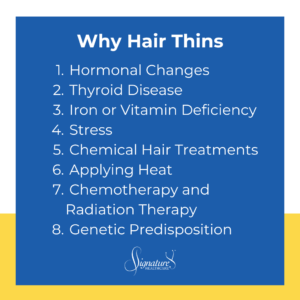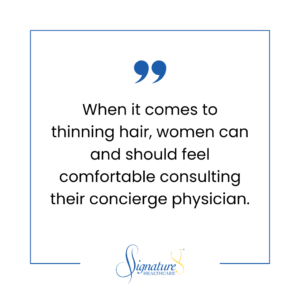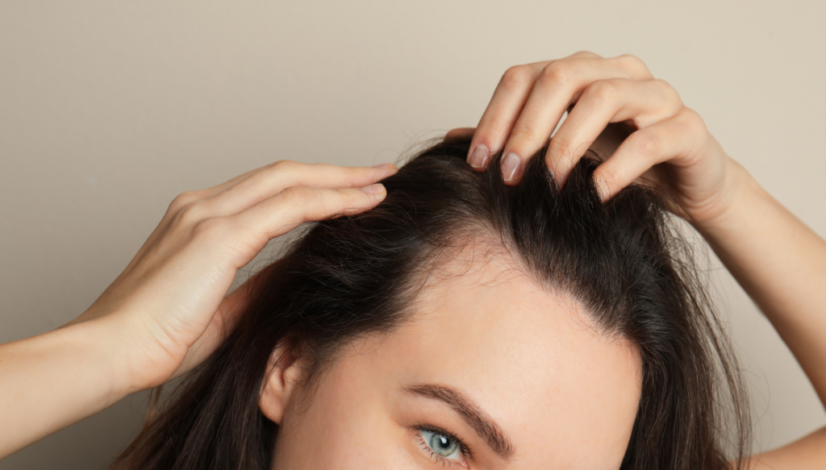Thinning Hair in Women: Everything You Need to Know
One day, you notice it: More and more of your hair is on your clothing or in the shower drain. You may even find clumps of it on your hairbrush.
Hair loss (clinically known as alopecia) is quite common in women. When menopause begins, hormonal changes can cause your hair to fall out. And alopecia isn’t just for older women. Besides thin hair, women may see hair loss whenever their hormones fluctuate, like during pregnancy or postpartum.
Alopecia may not be easy to turn around — everyone responds differently to treatment. But for most women, reducing hair loss and often considerably improving it is possible.

Why Hair Thins
To understand and manage their thin hair, women should work with their doctors to consider potential causes. Here are eight possibilities:
- Hormonal changes: This is the most common cause of hair loss in women. Hair shedding may occur during pregnancy, menopause, or other hormonal shifts.
- Thyroid disease: A dysfunctional thyroid can affect the scalp, leaving hair dry, brittle, and prone to breakage.
- Iron or vitamin deficiency: Low iron limits hair growth and causes hair to shed.
- Stress: A woman’s hair follicles may temporarily go dormant during considerable stress. As the hair cycle progresses and follicles gradually reactivate, dead hair may shed at a higher volume as much as two or three months later, well after the stressful event.
- Chemical hair treatments: Chemicals can damage the hair shaft and alter hair structure, rendering hair dry and brittle and leading to breakage.
- Applying heat: Repeatedly using curling irons, flat irons, and blow dryers damages keratin protein and dries out the hair.
- Chemotherapy and radiation therapy: Intensive chemotherapy may temporarily damage hair follicles and cause short-term hair loss. Some newer therapy regimens often avoid this outcome.
- Genetic predisposition: Female-pattern alopecia often runs in families, with many female family members facing hair loss, bald patches, or thinning as they age.
Treating Hair Loss
Oral treatments
Traditionally, minoxidil topical ointment was the treatment of choice. Patients applied it to the scalp daily, let it sit, and then rinsed it out, but many weren’t happy with the lotion’s mess and inconvenience.
Newer oral treatment regimens are a more effective and patient-friendly solution. Three types of tablets are currently available to patients for off-label use; in other words, the FDA has approved these medications for other purposes, but doctors recognize that they encourage hair growth, too:
Doctors commonly prescribe these tablets to treat hair loss in men and post-menopausal women — an important distinction because, for women of childbearing age, the medications may cause birth defects.
Oral treatments may have mild side effects. For example, minoxidil is a vasodilator and can cause headaches or swelling of the hands and feet. Finasteride can also cause headaches. However, the doses commonly prescribed for hair loss are low enough that such symptoms are rare.
Microneedling
When a hair loss specialist applies tiny needles to a patient’s scalp, the small “traumas” may reactivate hair follicles and spur hair growth in the needled areas.
Platelet-rich plasma (PRP)
Technicians remove blood from your arm, process it in a centrifuge, and reinject concentrated platelets into your scalp. PRP has been found to prevent hair loss, expedite new growth, and stimulate the scalp after a transplant.
Hair transplantation
Hair loss specialists harvest mini-grafts from denser areas of hair to fill in areas of subtle thinning.
Low-level laser therapy
Laser treatments are costlier than medication but stimulate blood flow and hair growth in the scalp. They’re often as effective as minoxidil, and the two combined are particularly successful.
A word about “miracle cures”
You know you’re “of a certain age” when Facebook and Instagram serve you ads for hair loss treatments. I caution my patients to beware of products touted on social media that sound too good to be true — some may be effective, but many make fraudulent claims.
A conversation with your physician or hair loss specialist is always preferable to ordering a “miracle product” online. Invest your money in proven approaches.
Be Kind to Your Hair
Can you prevent or minimize hair loss? The first step in good hair care is to care for yourself:
- Eat a nutritious diet.
- Exercise regularly.
- Do your best to minimize stress.
- Avoid fad or crash diets — sudden weight loss is associated with alopecia, so “slow and steady” is better.
Here are some other ideas to encourage stronger, healthier hair:
- Sleep on a satin pillowcase. Friction from cotton pillowcases can tug on fragile or thinning hair. A satin case is an inexpensive and gentler investment.
- Massage your scalp. It feels good, helps with stress, and — like the laser treatment mentioned earlier — may stimulate circulation that helps hair grow.
- Avoid extensions, braids, or fancy hairstyles that tug or stretch hair and make it fall out.
- Minimize applying heat (blow dryers and flat irons) or chemical treatments to your hair, and don’t color it more than necessary.
Be kind to your hair — it will like you back!
Stop the Shed
Concerned about the hair you’re losing? When it comes to thinning hair, women can and should feel comfortable consulting their concierge physician. We can screen for any underlying conditions that may need treatment. (Frankly, these more serious causes of hair loss are less common than people fear.)
For most women whose hair is thinning, your Signature Healthcare team can identify why it’s occurring and work with you to find a safe, effective treatment.


Dr. Elizabeth Perry
Dr. Perry is board-certified in internal medicine, holding a medical degree from the Medical College of Virginia. She completed residencies in internal medicine at the University of Pennsylvania Hospital and in emergency medicine at Johns Hopkins Hospital. Dr. Perry served as the chairperson of the Health Services Committee for the Charlotte Chamber of Commerce in 2006-07 and received the Charlotte Business Journal’s “Women in Business Achievement Award” in 2006. She, her husband Jon, and their three children enjoy outdoor activities and travel.
Get the latest News
Join the Signature Healthcare Newsletter to get the latest articles, resources, and news delivered directly to your inbox.

